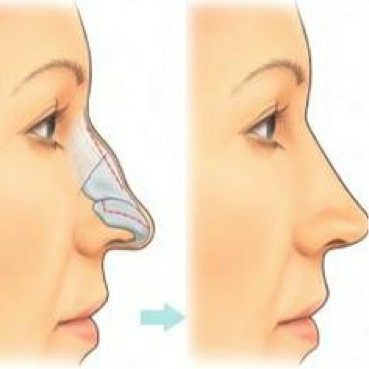Rhinoplasty/Nose Job
Rhinoplasty Surgical Procedure
 Rhinoplasty (nose job) is a surgical procedure of the nose performed to change its outward appearance. Many people wish to change the shape of their nose, whether it be a hump reduction, tip refinement or both which they were born with. In some cases, a nasal deformity is induced by trauma. A trauma or injury can lead to a deviation and a “twisted” appearance of the nose. With aging, the nose can begin to lengthen and droop due to the weakening of the cartilage and cartilaginous supports of the nose. Some of our Los Angeles rhinoplasty patients also have difficulty breathing as well. Often fixing the nasal passageways to allow for proper airflow is covered by insurance which then significantly minimizes your out-of-pocket costs towards the cosmetic portions of the procedure.
Rhinoplasty (nose job) is a surgical procedure of the nose performed to change its outward appearance. Many people wish to change the shape of their nose, whether it be a hump reduction, tip refinement or both which they were born with. In some cases, a nasal deformity is induced by trauma. A trauma or injury can lead to a deviation and a “twisted” appearance of the nose. With aging, the nose can begin to lengthen and droop due to the weakening of the cartilage and cartilaginous supports of the nose. Some of our Los Angeles rhinoplasty patients also have difficulty breathing as well. Often fixing the nasal passageways to allow for proper airflow is covered by insurance which then significantly minimizes your out-of-pocket costs towards the cosmetic portions of the procedure.
Ethnic Rhinoplasty
In Southern California, another frequently performed surgery is ethnic rhinoplasty. This type of procedure provides additional challenges to preserve the characteristic features of the nose while refining other areas. Often this requires a combination of both reduction and augmentation rhinoplasty.
Revision Rhinoplasty
Rhinoplasty surgery can be divided into primary rhinoplasty and secondary or revision rhinoplasty. Primary rhinoplasty is nose surgery on a patient who has never had nasal surgery. Revision rhinoplasty is nose surgery on a patient who has previously had a rhinoplasty. Revision rhinoplasty is often done to correct subtle changes to the nose that the patient may not be completely satisfied with. It can also be performed to improve nasal breathing.
Open and Closed Rhinoplasty

If you have breathing concerns from a broken nose or deviated septum, our surgeons will work with many insurance companies and can often help the patient get at least part of the procedure covered. Call our office to see if your insurance can help cover your surgery costs.
The second approach used in Rhinoplasty is the open approach also referred to as the external approach. This is the name given to this rhinoplasty because a very small incision is made on the outside of the nose along the columella. This is the middle strut of the nose underneath the tip. Although an incision is made in the skin, this generally heals very well as our doctors are very meticulous during surgery specifically for the nasal incision. An external rhinoplasty is best for you if you want significant changes to the nasal tip, are getting a revision rhinoplasty, or need additional support to the nose from weakening of the nasal structures.
Financing Your Rhinoplasty
If you have breathing concerns from a broken nose or deviated septum, our surgeons will work with many insurance companies and can often help the patient get at least part of the procedure covered. Call our office to see if your insurance can help cover your surgery costs.
After Your Nose Surgery
Immediately following your surgery at one of our state-of-the-art surgery centers we will observe you as you wake up from the anesthesia while making sure you are comfortable and under medical supervision.
Once you are feeling better, medically stable and awake enough from the anesthesia you will be released to go home. You will need to have a driver to take you home as you will not be able to drive yourself. If you had general anesthesia during your nasal surgery we strongly recommend you have someone stay with you overnight to make sure you are comfortable.
Your doctor will see you back the next day and then one week after your surgery. A small cast is placed on the nose at the time of surgery. The cast will be removed on day 5-7. We usually do not have to formally pack the nose following surgery except in very rare circumstances. We often use a small piece of silastic sheeting to help protect the delicate nasal mucosa while you are healing. This will also be removed one week after your surgery.
For the first few days after your surgery, you can expect to have a stuffy nose with some difficulty breathing out of your nose. You may feel like you have a mild cold.
You may also have a mild headache. In general, pain is usually minimal and well controlled with prescription medication given to you after surgery.
You may also experience, some minor bleeding from the nose, this is completely normal and generally resolves in about 24-36 hours. If you have any significant nasal bleeding following the surgery you can use Afrin nasal spray to help stop the bleeding. You should only use Afrin if you have bleeding and not in an attempt to improve your breathing. The nasal incision can remain slightly red for an additional few weeks but this will fade to natural skin color. Most of our patients achieve their final results within several months after their rhinoplasty treatments. However, very minor residual swelling might linger, which is why patients should wait at least 12 months before seeking any additional procedures.
The following instructions should be followed after a rhinoplasty:
Ice Packs: For three (3) days following surgery, you should apply ice packs at least 4 times daily to the eye and cheek area. Patients that have had Rhinoplasty procedures avoid direct pressure on the nasal bridge and bandages.
Nasal Dressing: Keep mustache dressing on as long as you need it to absorb any drainage from the nose. It may be necessary to change your dressing every 20 minutes for the first 4-6 hours after surgery. If the dressing is saturated in 15 minutes or less, please notify the office.
Bathing: Do not get a tape or splint wet while bathing. Have someone help you wash your hair while you lean backward in the sink. Protect your face and be careful not to bump your nose. If you shower, use a dry washcloth or plastic wrap over splint/tape. You may wash your face being careful to only cleanse the area surrounding the area around the nasal tape/splint.
Movement: Treat your nose with care. Avoid situations that may result in your nose being bumped. Keep your head above your heart. If you wear glasses, do not allow your glasses to touch the bridge of your nose for 3 weeks. Apply tape to the bridge of your glasses then affix tape to your forehead to keep the glasses elevated and off the bridge of your nose.
Blowing your Nose: Do Not Blow Your Nose For 2 Weeks After Surgery! Any secretions in the nose should be drawn back and expectorated through the mouth. If you sneeze, keep your mouth open during the sneeze. After two weeks you may blow your nose gently when needed.
Healing Process: Nasal splints will be removed the day after surgery. External nasal splint or tape (if applied) will be removed one week after surgery. Internal nasal sutures are absorbable. The external nasal sutures will be removed within 7 days. It takes 6-8 weeks for the inside of the nose to heal. We recommend avoiding contact sports for a minimum of 3 months following this surgery.
Schedule Your Rhinoplasty Consultation Today by calling either our Encino or West Hills office.
